Featured
- Get link
- X
- Other Apps
How to cook plantain: Tips for Frying, Baking, and Smashing
When it comes to versatile ingredients, plantains are at the top of the list. Whether you’re frying them to crispy perfection, baking them for a healthier treat, or smashing them into something uniquely delicious, plantains can transform your meals in amazing ways.
You might be familiar with plantains from dishes you’ve seen or tried from Caribbean, African, or Latin American cuisines. But if you’re not sure how to cook plantain—or if you’re wondering which cooking method works best—you’re in the right place.
In this guide, we’re diving deep into everything you need to know about plantains. We’ll cover the basics, from choosing the right plantain to mastering different cooking methods. By the end, you’ll have the confidence to fry, bake, or smash plantains like a pro.
Ready to up your plantain game? Let’s get started.

Understanding Plantains: What You Need to Know
Before we dive into cooking techniques, it’s important to understand what plantains actually are. They might look like bananas, but they’re a whole different ball game when it comes to flavor, texture, and how they’re used in cooking. Let’s break down the basics so you know what you’re working with.
What are Plantains?
Plantains are a starchy fruit that belong to the banana family, but they’re not quite as sweet. In fact, they’re typically used in savory dishes, especially when they’re green or only slightly yellow. The more they ripen, the sweeter they get, which makes them more versatile depending on the dish you’re going for.
Unlike bananas, you wouldn’t normally eat a raw plantain because it’s pretty firm and can even taste a little bitter when it’s unripe. But once you cook them, they soften up and take on a flavor that ranges from mildly starchy to sweet, depending on how ripe they are.

Plantains vs. Bananas: Key Differences
At first glance, plantains and bananas might seem like twins, but they’re more like distant cousins when it comes to taste and how you use them in cooking. Here’s a quick breakdown of the key differences:
- Texture: Bananas are soft and sweet, perfect for snacking or baking into a bread. Plantains, on the other hand, are firm and starchy, especially when they’re green. As they ripen, plantains do get softer and sweeter, but they still keep more of their structure than a banana.
- Taste: While bananas are sugary and sweet right from the start, plantains have a mild flavor when green and develop sweetness only as they ripen. That’s why you’ll find green plantains used in savory dishes like tostones, while ripe plantains work better in sweeter recipes.
- How They’re Used: Bananas are mostly eaten raw or used in desserts, whereas plantains are almost always cooked. You can fry, bake, boil, or smash them, depending on the recipe.

Think of plantains as the heartier, more flexible version of a banana—they can hold up to different cooking methods and take on a range of flavors.
Types of Plantains: Green, Yellow, and Black
Plantains go through different stages of ripeness, and each stage brings a new flavor and texture to the table. Here’s what you need to know about green, yellow, and black plantains:

- Green Plantains: These are the least ripe and the most starchy. They’re firm and have a more neutral, almost savory flavor, making them perfect for frying into tostones or chips. If you’re looking for a crispy side dish or snack, green plantains are your go-to.
- Yellow Plantains: As plantains ripen, they turn yellow and become a little softer. The starches begin to break down, and you’ll notice a slight sweetness starting to develop. These are great for dishes where you want a balance of sweet and savory, like maduros (sweet fried plantains).
- Black Plantains: Don’t toss those black plantains—they’re fully ripe and the sweetest of the bunch! They’re super soft and perfect for recipes where you want a dessert-like sweetness. Think of them as the plantain version of bananas for baking, mashing, or sweet frying.
Each stage of ripeness has its own unique use in the kitchen, so it’s all about choosing the right one for the dish you have in mind.
Nutritional Benefits of Plantains
Plantains aren’t just versatile in the kitchen—they’re packed with nutrients that make them a healthy addition to your meals. Whether you’re frying, baking, or smashing them, you’re getting a range of health benefits:

- Rich in Fiber: Plantains are high in dietary fiber, which helps with digestion and keeps you feeling full longer. This makes them a great option if you’re looking for a satisfying, nutrient-dense side dish.
- Vitamins and Minerals: Plantains are loaded with vitamins like Vitamin C and Vitamin A. They also provide a good dose of potassium, which is important for maintaining healthy blood pressure and supporting heart health.
- Complex Carbohydrates: Unlike regular bananas, plantains are more starchy, which means they give you a slow and steady release of energy. This makes them ideal for keeping your energy levels up throughout the day.
- Low in Fat: When cooked without added fats (like baking or boiling), plantains are naturally low in fat. They’re a great option if you’re looking to enjoy a hearty, filling dish without overloading on unhealthy fats.
Incorporating plantains into your meals not only adds flavor and texture but also gives your body a nutrient boost!
Preparing Plantains for Cooking
Before you start frying, baking, or smashing, it’s important to properly prepare your plantains. The way you handle them—right from choosing the perfect ripeness to peeling and cutting—can make or break your dish. Let’s go through each step so you know exactly how to prep your plantains for any cooking method.
How to Choose the Right Plantain for Cooking
The first step to cooking plantains is picking the right ones. Depending on what you want to cook, you’ll need to choose the right level of ripeness:

- For frying (like tostones or plantain chips): Go for green plantains. These are starchy and firm, which makes them ideal for frying until crispy.
- For sweet fried or baked plantains: Yellow plantains with a few black spots are perfect. They’re softer but not too mushy, and they have just the right amount of sweetness for dishes like maduros.
- For mashing or dessert recipes: Choose fully ripe, black plantains. These are super sweet and soft, making them ideal for mashing into savory or sweet dishes.
Peeling and Cutting Plantains: Step-by-Step Guide
Peeling a plantain isn’t as easy as peeling a banana. Here’s a quick guide to make it less of a hassle:
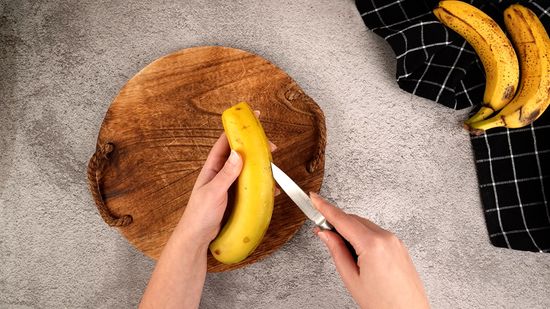
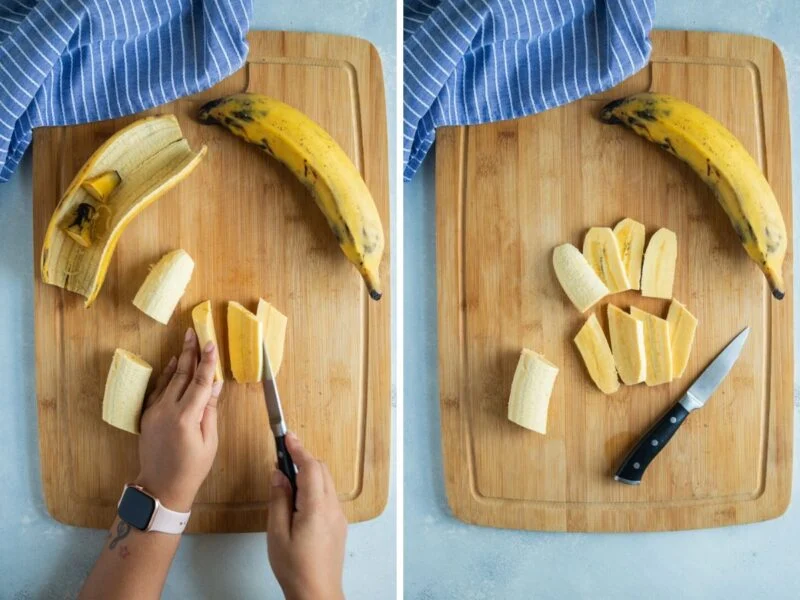
- Cut off both ends of the plantain.
- Make a shallow slit along the length of the skin (without cutting into the flesh).
- Use your fingers or a knife to pry open the skin along the slit and peel it away from the plantain. The greener the plantain, the tougher the skin will be, so be patient!
Once peeled, you can slice or cut the plantain depending on the recipe. For frying, thin slices work best for chips, while thicker slices are ideal for frying into tostones or maduros.
Ripeness Levels and Their Impact on Flavor
The ripeness of the plantain makes a big difference in how it tastes:

- Green Plantains: Neutral, almost savory flavor. Best for crispy dishes like chips or tostones.
- Yellow Plantains: Slightly sweet, with a softer texture. Great for frying into sweet side dishes or baking.
- Black Plantains: Very sweet and soft. Perfect for mashing, baking, or making dessert-like dishes.
Choosing the right ripeness is key to getting the flavor profile you want!
Storing Plantains: Best Practices
To make sure your plantains are always ready to use, proper storage is essential:

- Green plantains: Can be kept at room temperature for a few days. If you need to slow down the ripening process, put them in the fridge.
- Ripe (yellow or black) plantains: Store at room temperature if you’re going to use them soon. If they’re too ripe and you’re not ready to cook them, place them in the fridge to slow down further ripening.
You can also freeze plantains—just peel and cut them into slices before freezing. They’ll keep for a few months, and you can cook them straight from frozen.
Frying Plantains: Tips for Perfectly Crispy Results
Fried plantains are a staple in many cuisines, but getting them just right can take a bit of practice. Whether you want them crispy and savory or sweet and caramelized, these tips will help you nail the perfect fry every time.

Best Oil for Frying Plantains
Choosing the right oil is crucial to getting that crispy, golden-brown finish on your plantains. The best oils for frying plantains are those with a high smoke point, such as:
- Vegetable oil: Affordable and easy to find, this is a go-to option for frying.
- Peanut oil: Another great choice for frying because of its high smoke point and neutral flavor.
- Coconut oil: If you want to add a hint of coconut flavor, this oil works well, though it has a slightly lower smoke point compared to the others.
Avoid oils like olive oil, which can burn quickly at high temperatures and affect the flavor of your plantains.
How to Cook Plantain: Frying Techniques for Crispiness
Achieving perfectly crispy plantains isn’t complicated, but it does require the right technique. Here’s how you can fry plantains to get that crisp, golden texture:
- Heat the oil: Pour enough oil into a frying pan to submerge the plantain slices halfway. Heat the oil over medium-high heat until it’s hot but not smoking.
- Prepare the plantains: Slice your plantains to the desired thickness—thicker slices for a soft inside with a crispy edge, or thinner slices for chips.
- Fry in batches: Don’t overcrowd the pan. Fry the plantains in batches, flipping them once the edges start to brown. Each side should take about 2-3 minutes, depending on thickness.
- Drain excess oil: Once the plantains are golden and crispy, remove them and place them on a paper towel to drain any excess oil.
By following these steps, you’ll avoid soggy or greasy plantains and get the perfect crunch.
Twice-Frying Plantains for Extra Crunch (Tostones)
If you want to take your plantains to the next level, try making tostones. This method involves twice-frying the plantains to give them an extra crunchy texture:
- Fry once: Fry thick slices of green plantain for about 2 minutes on each side until they’re golden but still soft in the middle.
- Smash them: Remove from the oil, and while they’re still warm, gently smash the plantains using a tostonera (a plantain press) or the bottom of a cup.
- Fry again: Fry the smashed plantains for another 2-3 minutes on each side until they’re super crispy.
- Season and serve: Sprinkle with salt or dip them in garlic sauce for an irresistible snack or side dish.
Sweet Fried Plantains: The Perfect Side Dish
For a sweeter take on fried plantains, use yellow or slightly black plantains. They’ll caramelize as they fry, giving you a delicious balance of sweet and savory:
- Use ripe plantains: Choose plantains that are yellow with some black spots or fully black for the sweetest results.
- Fry in medium heat: Frying at medium heat allows the plantains to cook evenly without burning the sugars that develop as they ripen.
- Add a sprinkle of sugar (optional): For an extra caramelized touch, sprinkle a little sugar on the plantains while they’re still warm.
Sweet fried plantains pair perfectly with savory dishes, offering a tasty contrast in flavors.
Common Frying Mistakes to Avoid
Even seasoned cooks can run into some issues when frying plantains. Here are a few common mistakes and how to avoid them:
- Overcrowding the pan: This traps steam and prevents the plantains from getting crispy. Fry in batches for the best results.
- Oil too cold or too hot: If the oil isn’t hot enough, the plantains will absorb too much oil and turn greasy. If it’s too hot, they’ll burn on the outside while staying raw inside. Aim for medium-high heat and adjust as needed.
- Slicing too thin or too thick: Thin slices can burn easily, while overly thick slices may not cook through properly. Try to keep your slices uniform for even cooking.
Baking Plantains: A Healthier Alternative
If you’re looking for a healthier way to enjoy plantains without all the frying, baking is the perfect option. It’s easy, less messy, and still brings out that delicious sweetness or crispiness, depending on how you prepare them.

How to Bake Plantains: Step-by-Step Instructions
Baking plantains is simple and requires just a few ingredients. Here’s how to get them perfectly baked every time:
- Preheat the oven: Set your oven to 400°F (200°C).
- Prepare the plantains: Peel the plantains and slice them lengthwise or into round pieces, depending on how you want to serve them.
- Season them: Brush the plantain slices with a bit of oil and season with salt, pepper, or spices, depending on the flavor you’re aiming for.
- Bake: Place the plantain slices on a baking sheet lined with parchment paper. Bake for about 15-20 minutes, flipping halfway through, until they’re golden and tender.
- Cool and serve: Once they’re baked, let them cool slightly before serving. You can enjoy baked plantains as a side dish, snack, or part of a main meal.
Baked Plantain Chips: A Healthy Snack Recipe
If you’re craving a crunchy snack but want to skip the frying, baked plantain chips are the way to go. Here’s how to make them:
- Thinly slice the plantains: Use green or slightly yellow plantains for chips. Slice them as thin as possible—using a mandoline works best.
- Season and bake: Brush the slices with oil and sprinkle with salt or your favorite seasoning (like paprika or garlic powder). Bake at 375°F (190°C) for 15-20 minutes, flipping halfway through.
- Cool to crisp: Once baked, let the chips cool completely to achieve maximum crunchiness.
These chips make a great, healthy alternative to regular potato chips and are perfect for dipping in salsa, guacamole, or hummus.
Tips for Maintaining Moisture and Flavor in Baked Plantains
Baked plantains can sometimes turn out dry if not done correctly. Here are some tips to keep them moist and flavorful:
- Brush with oil: Lightly brushing the plantains with oil before baking helps them stay moist and enhances flavor. Olive oil, avocado oil, or even coconut oil works well.
- Cover with foil: For softer baked plantains, cover the baking dish with foil for the first 10-15 minutes of baking, then uncover to finish.
- Use ripe plantains: The riper the plantain, the more moisture it has. If you want a sweeter, softer result, opt for fully yellow or black plantains.
Best Seasonings for Baked Plantains
Baked plantains can take on a variety of flavors depending on how you season them. Here are some great options to try:
- Savory: Sprinkle your plantains with salt, garlic powder, smoked paprika, or cumin before baking for a savory side dish.
- Sweet: For a sweet treat, sprinkle with cinnamon and a little sugar. You can also drizzle honey or maple syrup over them once they’re baked.
- Spicy: If you like a bit of heat, add chili powder or cayenne pepper to the seasoning mix. Sweet and spicy baked plantains are a match made in heaven!
Smashing and Mashing Plantains: Unique Recipes to Try
Plantains aren’t just for frying or baking—you can also smash and mash them to create delicious, hearty dishes. Whether you’re looking for a savory breakfast or a traditional dish with a twist, smashing or mashing plantains opens up a whole new world of recipes.

How to Make Mangu: A Dominican Delight
Mangu is a beloved Dominican dish made from boiled and mashed green plantains. It’s typically served for breakfast, often with eggs, cheese, or salami. Here’s how to make it:
- Boil the plantains: Peel and cut green plantains into chunks. Boil them in salted water until they’re soft, about 20-25 minutes.
- Mash with butter or oil: Drain the plantains and mash them with a fork or potato masher. Add a bit of butter or olive oil to make them creamy.
- Add flavor: For a true Dominican experience, stir in some sautéed onions and a splash of vinegar. Season with salt and pepper to taste.
- Serve with sides: Mangu is often served with fried eggs, fried cheese, or slices of cooked salami for a complete and satisfying meal.
Mashed Plantains with Garlic: A Savory Twist
If you’re in the mood for something savory, mashed plantains with garlic is a simple yet flavorful side dish. Here’s how to whip up this garlicky goodness:
- Boil the plantains: Just like with mangu, boil green plantains until they’re tender.
- Mash and flavor: Mash the plantains with a couple of minced garlic cloves and some olive oil. Add a touch of salt and pepper for seasoning.
- Add a splash of broth: For extra flavor and moisture, stir in a bit of vegetable or chicken broth while mashing. This creates a creamy, flavorful consistency.
Serve this savory dish alongside grilled meats, stews, or as a stand-alone snack.
Smashed Plantains for Breakfast: Quick and Easy Ideas
Looking for a quick breakfast option that’s different from the usual routine? Smashed plantains are easy to prepare and pair well with various toppings:
- Fry and smash: Peel and slice yellow plantains. Fry them until golden, then smash them with the back of a spoon or a plantain press.
- Top with eggs: Smashed plantains make the perfect base for sunny-side-up eggs or scrambled eggs. Add a sprinkle of cheese or avocado for a balanced breakfast.
- Sweet or savory toppings: You can go sweet by drizzling honey or maple syrup over the smashed plantains, or keep it savory with a dash of hot sauce and a side of bacon.
These smashed plantains are a simple yet filling option for a quick breakfast that packs a flavorful punch.
Plantain Recipes from Around the World
Plantains are a staple in many cultures, each with its own unique spin on how to cook and enjoy them. From savory to sweet, here are some of the best plantain dishes from across the globe.
Caribbean Plantain Dishes You Need to Try
The Caribbean is home to some of the most flavorful and creative plantain recipes. Here are a few must-try dishes:
- Tostones (Twice-Fried Plantains): This classic Caribbean dish is made by frying green plantains, smashing them flat, and frying them again for an extra-crispy snack or side dish. Tostones are often served with a garlic dipping sauce or as a side to grilled meats.
- Maduros (Sweet Fried Plantains): These are made with ripe, yellow plantains. Fried until caramelized and golden, maduros are sweet and tender, making them the perfect complement to savory dishes or a stand-alone snack.
- Plantain Porridge: In some Caribbean countries like Jamaica, plantains are boiled and mashed into a creamy porridge. This dish is often sweetened with condensed milk and spiced with nutmeg or cinnamon for a comforting breakfast option.



African Plantain Recipes: Bringing the Taste of Home
Plantains are also a significant part of West African cuisine, where they’re prepared in a variety of ways:
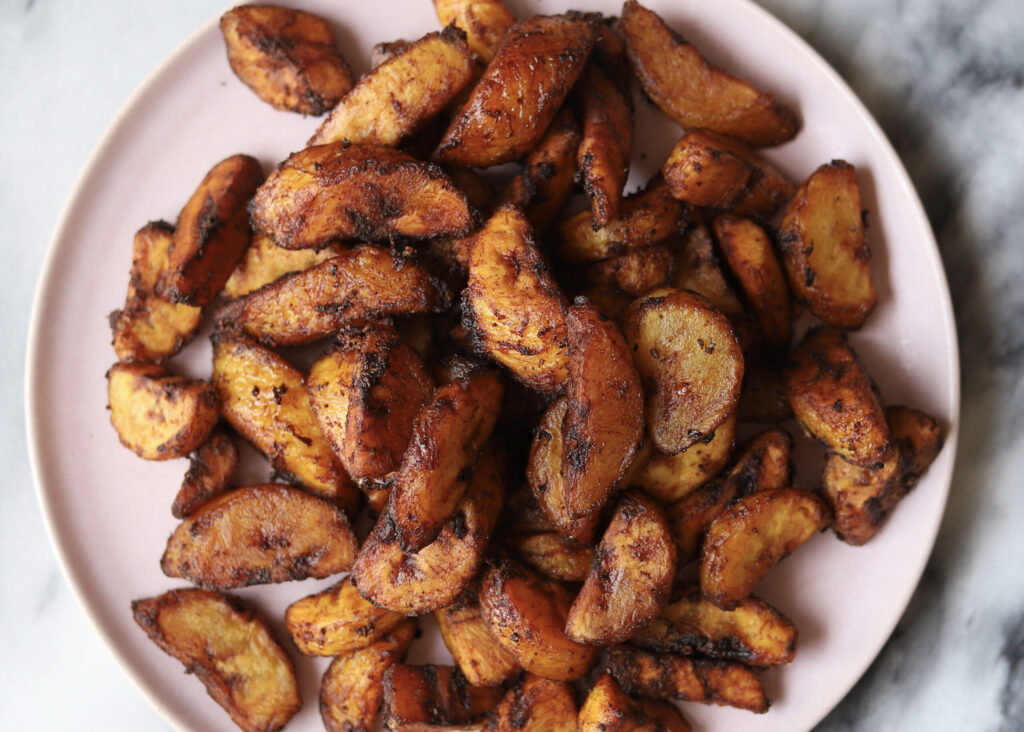
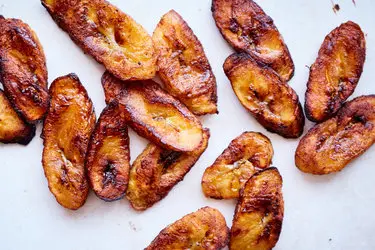
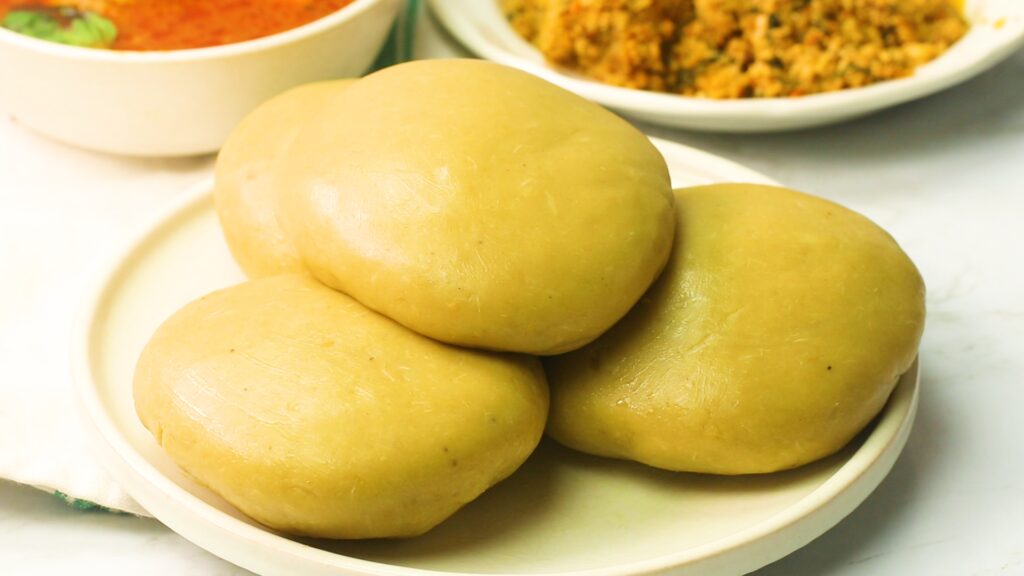
- Kelewele (Spicy Fried Plantains): This popular Ghanaian street food is made from diced, ripe plantains seasoned with spices like ginger, cayenne pepper, and garlic, then deep-fried until crispy. Kelewele has a sweet, spicy kick that makes it a perfect snack or side dish.
- Dodo (Fried Ripe Plantains): In Nigeria, dodo is a go-to side dish. Ripe plantains are sliced and fried until golden-brown. They’re typically served alongside rice, beans, or stews, and offer a hint of sweetness to balance out the savory flavors of the main dishes.
- Plantain Fufu: This dish involves boiling green plantains and mashing them into a dough-like consistency, similar to traditional fufu made from cassava or yams. Plantain fufu is often served with soups or stews in various parts of West Africa.
Latin American Plantain Dishes: Tostones, Mofongo, and More
Latin American cuisine takes plantains to the next level with creative and flavorful recipes:


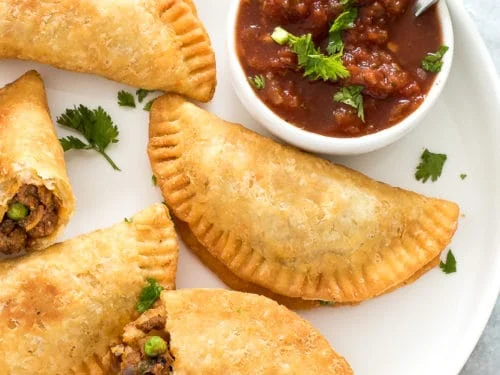
- Mofongo: A Puerto Rican favorite, mofongo is made by mashing fried green plantains with garlic, pork cracklings, and a touch of olive oil. It’s served as a side dish or stuffed with meats and seafood for a hearty meal.
- Patacones (Tostones): Similar to Caribbean tostones, patacones are popular in Latin American countries like Colombia and Venezuela. They’re made by smashing and twice-frying green plantains, often served with toppings like avocado, shredded meat, or cheese.
- Plantain Empanadas: In many Latin American countries, ripe plantains are mashed and used to make the dough for sweet or savory empanadas. They’re filled with anything from beef and cheese to sweet fillings like guava or caramel.
FAQs about Cooking with Plantains
When it comes to cooking with plantains, there are a lot of common questions people have. Here are the answers to some frequently asked questions that will help you get the most out of this versatile ingredient.
While bananas are often eaten raw, plantains are almost always cooked. Raw plantains have a tough, starchy texture and are typically bitter, especially when green. For the best flavor and texture, plantains should be fried, baked, boiled, or mashed. However, once they are fully black and ripe, some people do enjoy them raw, but that’s a rare exception.
The ripeness of a plantain depends on its color:
- Green Plantains: These are unripe and very starchy. They’re perfect for frying into tostones or making chips.
- Yellow Plantains: These are semi-ripe, with a mix of sweetness and firmness. They’re great for frying into maduros or baking.
- Black Plantains: Fully ripe plantains are sweet, soft, and perfect for baking, mashing, or using in dessert-like dishes.
Plantains and potatoes have different nutritional profiles, but both are healthy in their own right. Here’s a quick comparison:
- Calories: Plantains and potatoes are similar in calories, but plantains tend to have slightly more due to their natural sugars when ripe.
- Fiber: Plantains are higher in fiber, which aids digestion and keeps you full longer.
- Vitamins and Minerals: Plantains are rich in Vitamin A, Vitamin C, and potassium, while potatoes have more Vitamin B6 and Vitamin C.
Conclusion: Exploring the Versatility of Plantains
Plantains are one of those ingredients that can truly do it all. Whether you’re frying them up for a crispy snack, baking them for a healthier alternative, or mashing them into a savory side dish, there’s no shortage of ways to enjoy plantains. From breakfast to dinner, and even dessert, plantains can bring both sweet and savory flavors to the table.
Now that you know the ins and outs of picking, preparing, and cooking plantains, you’re ready to take on some of the most delicious plantain recipes from around the world. Whether it’s making tostones, trying out sweet fried plantains, or diving into dishes like mangu or mofongo, plantains can elevate any meal with their rich flavor and versatility.
So, grab some plantains, get creative in the kitchen, and enjoy all the delicious possibilities this humble fruit has to offer!
Disclosure: Our blog contains affiliate links to products. We may receive a commission for purchases made through these links. However, this does not impact our reviews and comparisons. We try our best to keep things fair and balanced, in order to help you make the best choice for you.
source https://sazonytumbao.com/how-to-cook-plantain/
- Get link
- X
- Other Apps
Popular Posts
Street Food Culture in the Caribbean: A Culinary Journey
- Get link
- X
- Other Apps
Comments
Post a Comment